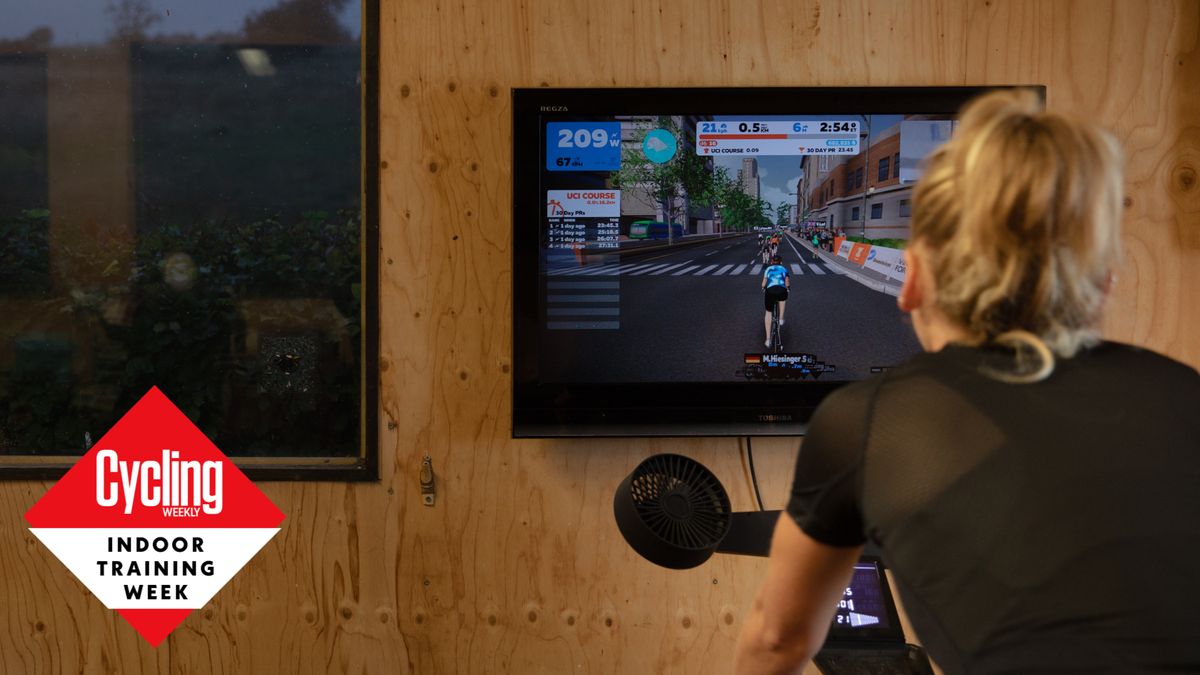The massive indoor community and a winding network of virtual roads are probably the first thoughts that float before your mind at the mention of Zwift. That and the ever-developing e-racing scene, of course.
But all that’s not even to mention the huge bank of training sessions sitting there on one of the best indoor training apps for cycling, it’s a really great resource and one that you should definitely be tapping into – but just where to start?
If you really are just setting out on your Zwift journey and still need an indoor trainer we have guides to the best cheap smart trainers alongside the best smart turbo trainers that includes trainers at a host of different price points.
We’ve had Andy Turner, head coach of ATP Performance – and resident training expert here at Cycling Weekly comb through the sessions and pick out nine of the best.
With each, Turner digs into the details of exactly what the physiological benefits of the sessions are, breaking down what elements are targets and what gains you can expect. As an extra bonus, he’s given the same analysis to three of Zwift’s multi-week cycling training plans.
If all of this is putting the cart before the horse a bit, and you’re after more details on how to get set up riding Zwift, or the cheapest possible Zwift set-ups we’ve got a multitude of pages to help you out.
But if you’re just after the sessions, well, here we go…
The latest race content, interviews, features, reviews and expert buying guides, direct to your inbox!
Best Zwift workouts
Best Zwift workout to improve FTP
(Image credit: Zwift)
Zwift workout name: 2×15 FTP Builds
This workout starts with a progressive warm up, then dives straight into two 15 minute intervals at FTP with a 10 minute break in-between.
The progressive warm up is vital, as working at FTP is tough for this duration of time. The benefit of working at or around FTP is that it helps not just physiologically but also psychologically when it comes to maintaining this level of power.
Improving your FTP comes down to increasing your aerobic threshold, the effort that you can sustain maximally for longer periods of time. One way to do this is via long slow duration training (which takes up a lot of time) or by doing higher intensity intervals such as this session.
What makes this session one of the best zwift workouts for improving FTP is that it assists in reducing our time to exhaustion – how long we can sustain FTP – which, in turn, results in us being able to maintain a higher power for durations of up to 20 and 60 minutes.
Best Zwift workout for weight loss
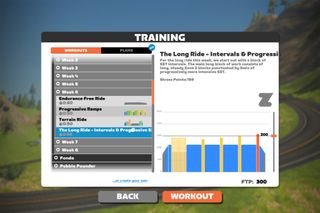
(Image credit: Zwift)
Zwift workout name: The Long Ride – Intervals & Progression
This session is primarily a Zone 2 endurance ride, but with sub-threshold and some supra-threshold efforts thrown in there. The reason this is the best zwift workout for weight loss is due to several factors.
Firstly, being nearly three hours long, this session expends a significant amount of energy – and therefore calories. If looking to shift some body fat, we want to create a calorie deficit, either by eating less or burning more. Eating less risks shedding muscle as well as fat, so burning more and eating enough to fuel your body creates a more optimal calorie deficit.
The other benefit to this session is that the efforts towards its end are above FTP and assist in creating an oxygen deficit (referred to as EPOC). This means that even after exercise has finished, we continue to use calories at a higher rate as we recover from the physiological effort of these higher intensity blasts.
Best Zwift HIIT workout
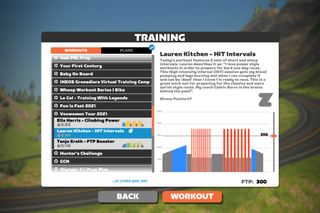
(Image credit: Zwift)
Zwift workout name: Lauren Kitchen – HIIT Intervals
This session combines a block of x10 30/30s and x8 45/45s, both conducted at around 120per cent of FTP which puts them firmly into the maximal aerobic power and above level of efforts, high intensity interval training that’s for sure!
The reason why I think this is the best HIIT workout on Zwift is that it’s all about very hard efforts and repeating them with limited recovery. So even when the power is low, you will find that your heart rate is still recovering and likely remain well elevated to where it would normally be for a recovery intensity of power.
These kinds of efforts are great for developing glycolytic power, improving recovery from efforts, and improving maximal aerobic function as our heart rate and oxygen consumption increase towards their maximums as the effort blocks go on.
Best Zwift workout for climbing
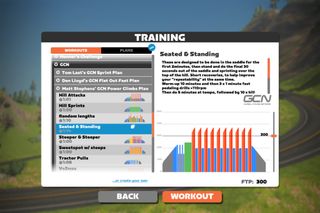
(Image credit: Zwift)
Zwift workout name: Seated and Standing
This is the best Zwift workout for those looking to improve their climbing ability. Not only does the workout start with some high cycling cadence efforts to give a bit of neuromuscular stimulus – warming the legs up nicely – but the main efforts combine both seated and out-the-saddle work, delivering a rounded training stimulus.
The biggest difference between riding on the flats and the climbs is that we are likely to spend more time out of the saddle on the climbs, so it’s nice to see a workout which addresses that. The efforts are only 2.5 minutes long, but they are hard ones and ramp up in power throughout the entire effort.
The first two minutes are done seated, with the final 30 seconds being a sprint over the top. The idea is as the effort level increases, the cadence drops and resistance increases, preparing you for climbs when the gradient increases and we need to get out of the saddle to get over them.
Best 1 hour Zwift workout
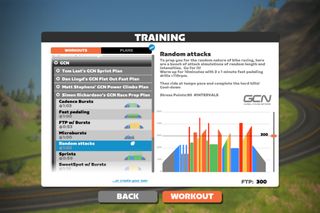
(Image credit: Zwift)
Zwift workout name: Random Attacks
The Random Attacks workout is a very fun one and the reason why I think it is the best Zwift workout if you’ve got an hour to spare (plus two minutes!). The session doesn’t repeat any of its efforts and includes a big mix of things to keep it interesting and you engaged in the session.
Once the warm up is over, it goes straight into race mode, with attack efforts flying left right and centre. That in itself makes this a great workout for those doing e-races, criteriums, and cyclocross races where the pace is hard from the start and the efforts are more random and variable. The large amount of time spent at or above FTP with limited recovery also makes this workout a hard one, but definitely a fun and useful one to complete.
Best Zone 2 Zwift workout
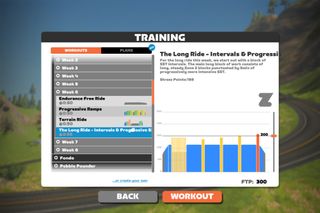
(Image credit: Zwift)
Zwift workout name: The Long Ride – 6x20min Tempo
There are not many predominantly Zone 2 workouts on Zwift that have structure, many of them are a free ride or jumping in with a Pace Partner at your Zone 2 power. However, this is the best Zwift workout for Zone 2 that we found – even though it calls itself a Tempo (Zone 3) workout, the actual power targets are still more Zone 2 rather than Tempo.
The session is a long one at 3.25 hours, but includes a good amount of time spent well into the higher end of Zone 2. The benefit to this is that it can be easy with Zone 2 rides to end up complacent and ride at too low an intensity. This session breaks the workout up into sections of Zone 1, and longer blocks of solid Zone 2, that remain below the first lactate threshold.
This also keeps things a bit more interesting and mentally engaging having the session broken up into multiple segments. It requires a good level of fitness to complete, so for those who are starting out with endurance training, maybe best to complete x3 of the 20min Tempo efforts to start.
Best Zwift recovery workout
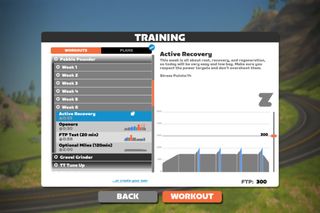
(Image credit: Zwift)
Zwift workout name: Active Recovery
As the name would clearly suggest, this is the best Zwift workout for recovery days. 33 minutes or riding at predominantly Zone 1 with some little excursions into Zone 2 just to get the heart beating a little more without generating any fatigue.
The big benefit of active recovery is the musculoskeletal pump. When we do hard efforts or high intensity/duration training, we generate fatigue metabolites that require clearing. The way to clear them is via increased blood flow, which is where a lot of recovery products claim to be beneficial such as massage guns and compression clothing.
Active recovery rides do this for us as they increase cardiac output, and therefore assist in the removal of the metabolites in our legs, without generating any fatigue metabolites themselves.
Best VO2 workout on Zwift
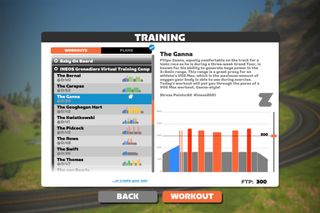
(Image credit: Zwift)
Zwift workout name: The Ganna, or Finish Focus
The Ganna – we already know by the name that this session is going to involve a fair amount of time at an intensity that we’re going to find uncomfortable. With a total of 15 minutes out of 50 spent at VO2max levels of power, this makes this the best zwift workout for VO2.
Although the efforts are short, they are very hard. The first two 30 seconds surges are just to get the legs up to speed for generating high power. Then it’s a two minute effort at 120 per cent of FTP – which is a lot harder than you think it will be, even though it’s only two minutes.
The next efforts are each five per cent easier, but also a minute longer at three and four minutes. Then if that wasn’t enough, you work your way back to two minutes of 120 per cent of FTP but now with a solid amount of fatigue in your legs. Working at this maximal aerobic capacity is a great way of improving VO2max.
Best Zwift workout for beginners
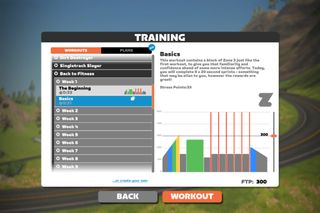
(Image credit: Zwift)
Zwift workout name: Basics
This session is the best Zwift workout for those just beginning to include structured workouts in their training and haven’t done any FTP (or similar) threshold testing. The Z3 block is an effort which will be more about feel and likely one which you will end up overdoing – as it’s a short interval and therefore easy to go too hard in.
But the six 20-second sprints are a great way of generating a high level of torque whilst keeping a high leg speed, assisting in muscle recruitment when cycling and also cycling specific leg strength. Being just over half an hour, it is also not an overly exerting session for those just starting out.
Best Zwift training plans
There’s not only workouts on Zwift to choose from, Zwift has all grouped these together in cycling training plans for those looking to follow a structured routine each week to progressively build towards their goals.
Best Zwift training plan for weight loss
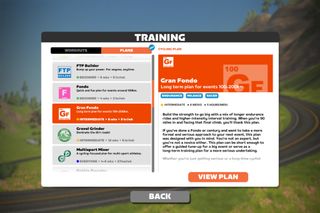
(Image credit: Zwift)
Zwift training plan name: Gran Fondo plan
This plan is the best Zwift training plan for weight loss, as it has the highest total volume of riding. Although shown as being only five hours a week, the rides at the weekend are referred to as ‘Endurance Free Rides’, meaning they can be significantly longer than the advertised 50 minutes.
Longer rides present the opportunity to ride at lower intensities (which burn fat) for a long duration (so the total amount of fat burned is high). Combine this with a calorie deficit of only 500-800, and then you will still have consumed an adequate amount throughout the day to avoid slipping into low energy availability.
The addition of many very good training sessions to improve aerobic performance will also help you burn more fuel at lower intensities – thus burning more fat – as well as helping increase the maximum power at which you continue to burn predominantly fats. There is also the excessive post oxygen consumption (EPOC) after the interval sessions during the week.
Best Zwift training plan for climbing
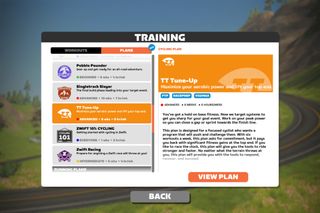
(Image credit: Zwift)
Zwift training plan name: TT Tune-up
Although not traditionally what you would consider to be the best Zwift training plan for climbing, the TT Tune-up is actually ideal for this.
A lot of the workouts in this plan are centred around being able to maintain a high power and heart rate for a prolonged period of time. This is ideal for longer climbs where due to the gradient you can’t really ease off the pedals – similar to in a time trial. Being able to produce higher powers for longer periods of time while maintaining a high heart rate is similarly very beneficial to climbing performance.
Additionally, there are plenty of sessions which work the anaerobic areas of power production needed for shorter and sharper climbs, – Week Six in particular has some good leg burners in there with Power Intervals, AC + Sweet Spot, and Neuromuscular + AC.
You can also use this plan to build up to a specific event, if you start nine weeks out from it: eight weeks for the plan, and one week for a taper.
Best Zwift training plan for beginners
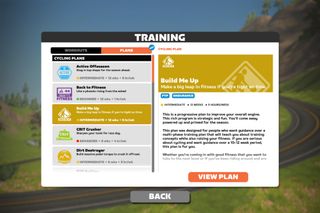
(Image credit: Zwift)
Zwift training plan name: Build me up
This is the best Zwift training plan for both beginners, and those resuming their training after a break, perhaps aiming to successfully bounce back after a crash (and injury).
The plan starts with assessing power benchmarks for determining power zones, and tests this again more regularly than most plans, as beginners can expect to see faster progression than experienced riders.
The sessions are a nice variety that will keep riders entertained. The wide range of efforts will also help riders determine what their strengths and weaknesses are on the bike. There is also a good number of sessions dedicated to pedalling technique and efficiency, very important for beginners – and a lot of more experienced riders as well – as this is something that often gets neglected.
A lot of the sessions are one hour or less, making them easy for most beginners to cycling to complete, without being too hard or taking up too much time in the day. On the weekends, some of the sessions stretch to 90 minutes. To finish off the plan, the final week builds you up to an FTP test, which will give you a good indication of how far you’ve come in the 12 weeks.

